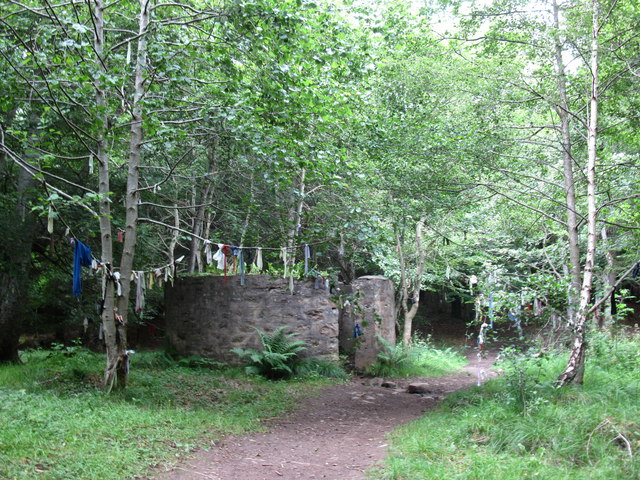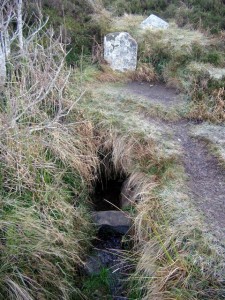Supernatural Ballads
An Introduction to the Supernatural
There are several ballads within the Minstrelsy which contain supernatural beings or events. Some, like “Annan’s Waters”, have a brief reference, which adds to but is not an essential part of the tale. In others, such as “Tam Lin” and “True Thomas”, the supernatural aspect is an essential component to the ballad.
Belief in supernatural world in all its various aspects was still prevalent in Sir Walter Scott’s time and, indeed, remnants of belief, ritual and processes are still to be found in practices and in geographic locations around Scotland, with wells, springs and trees being popular recepticles for votive offerings.
You may find nails or coins driven into the bark of a tree, coins or food left at a well, or cloots (or cloths) left behind by visitors who are seeking, for example, better health, or a safe journey. Some wells now have saints associated with them, but others, like the Cheese Well near Traquair in the Borders, are associated with the fairies, and most of these locations have associations with pre-Christian belief systems. Some of these locations are still used and the leaving of offerings is still often observed.
The barrier between the real world and an “invisible world” of supernatural beings was perceived to be a delicate thing, easily traversed by the humans of the real world – intentionally of otherwise and the beings of the supernatural realms, whether they be revenants, spectres, fairies or any other supernatural creature. Witchcraft also falls into the sphere of the supernatural, although in the ballads, most cursing or charming is perpetrated by mothers. This is not to say that there are no witches in the ballads – “Alison Gross” is a notable example, but that many characters which curse or charm are also primarily mothers, who are trying to protect or prevent a child from attaining a specific goal.
Communication, or contact with various creatures occur in the Minstrelsy ballads. Communication with and abduction by fairies occurs in two of the ballads – “Tam Lin” and “Thomas the Rhymer”; dealings with revenants occur in “The Wife of Usher’s Well” and “Clerk Saunders”; there is witchcraft in “Willie’s Lady”; and there is mention of a kelpie in “Annan’s Waters”.
Fairies
The fairies which these ballads are concerned with are very different from the presentations which became popular in the later nineteenth century onwards. They are not tiny, gossamer winged beings. Instead, we have beings of power, often of stature and physical strength, more akin to old gods of the pagan pantheon – or creatures which have human characteristics.
There are several notable descriptions of fairies from Scotland. Many of the descriptions come from people, who were being tried for witchcraft – people such as Isobel Gowdie, Elspeth Reoch, Andro Mann and Donald MacMichael. While the methods used to extract confessions have to be borne in mind, the descriptions the would-be witches gave often corresponded with commonly held beliefs regarding the fairy host.
Another source is a rather peculiar treatise, called The Secret Commonwealth, written by the Revd Robert Kirk around 1691. The treatise was first published in 1815 by Sir Walter Scott, and Andrew Lang subsequently published it in 1893, under the title The Secret Commonwealth of Elves, Fauns and Fairies. Kirk describes the behaviours of fairies, along with second-sight, and the nature of other supernatural entities. It may seem to be a peculiar subject for a minister to write about, especially in the way that Kirk does, but he views the belief in fairies and other supernatural aspects as a fact of life
There is a general differentiation between Highland and Lowland fairies. The Highland types are generally solitary, with notable physical attributes, which make it obvious that they are not human: for example, they may be covered in exceptionally shaggy hair, or they may have webbed feet, or they may have a distinctive cry. The word “banshee”, however, is derived from bean sidh, which merely means “fairy woman”. Those which do not attach themselves to a particular household (where they may perform tasks in repayment for the likes of milk or food), are often associated with desolate places.
In contrast, the lowland fairy is often described as living in tribes or bands, each with a king and queen. It is here, that differentiation is made between the “seely” and “unseely” courts, also known as “the gude wichts” and “the wicked wichts”. The former could be helpful and beneficent to humans, the latter, never, and various precautions could be taken to keep them at more than arm’s length.
Lowland fairies tend to be described as being beautiful, with the colours green and brown often associated with them, along with golden or silver accoutrements. Some reports describe them as small, others estimate their height being equal to that of a tall man. Their beauty and their stature may or may not be associated with shape-shifting abilities, which means that they could appear to a viewer in any form they wished. Fairies were known to be repulsed by iron, and it was used as a defence against their gaining entry to a house or to prevent them laying hands on an individual. The ballad fairy is most similar to the descriptions we have of lowland fairies. They inhabit a realm which operates out of the bounds of the mortal world, and which is neither truly evil nor divine – although there is some indication, in reports and in ballads such as “Tam Lin” that they do have contact with other realms as well as that of mortals.
The fairy queen is one of the most adorned and powerful individual within the Lowland fairies. In the ballads, she is seductive and powerful, but can also be well disposed towards some mortals.
Ghosts and Revenants
Ballad ghosts are corporeal and even when they are referred to as ghosts, they are more like a revenant, or an animated corpse. They can be seen clearly by mortal characters, they often refer to their lips and breath being like the clay or having the smell of the ground , and they often have to return to the grave once dawn is on the way. They may be called back to the mortal world by grieving lovers or parents, as in “The Wife of Usher’s Well”; they may function as a conscience, especially if there is an undiscovered crime, as in “The Cruel Mother”; or to ensure that their body is located and they may attain rest, as in “Little Sir Hugh” – which also suggests some intention of revenge or vengeance. Some, however, seek only to communicate with their loved ones: after his burial, the murdered Clerk Saunders returns to his true love to free her – and himself – from their lovers’ troth: he does not mention, in any version of the ballad, a desire for vengeance on his lover’s brothers, who plotted to kill him.
________________________________________
Image credits:
St Mary's Well,near Smithton:
This is a clootie well where the clootie (cloth) is left to hang as a cure for illnesses.
© Copyright don cload and licensed for reuse under this Creative Commons Licence
The Cheese Well, near Traquair:
The spring at the Cheese Well is a shrine where, traditionally, offerings are made to the fairies of the hills. An offering was made by the photgrapher.
© Copyright Gordon Brown and licensed for reuse under this Creative Commons Licence.


